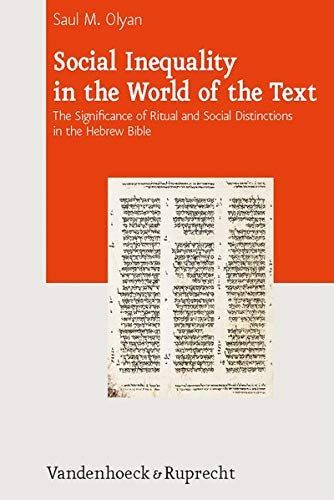
Social Inequality in the World of the Text The Significance of Ritual and Social Distinctions in the Hebrew Bible
English description: This volume consists of fifteen of the authors essays, including two that have never been published before. The essays date to the last decade and a half, and all reflect in some manner the authors ongoing interest in literary operations of classification and their social implications, particularly the production of distinctions which create social inequality in the world of the text, and have the potential to generate hierarchical social relationships in contexts where biblical texts might have had an impact on real people. In these essays, the author explores themes such as gender, sexuality, purity and pollution, sanctification, death and afterlife, foreignness, and disability with particular attention to the roles distinctions such as honored/shamed, feminine/masculine, mourning/rejoicing, unclean/clean, alien/native play in creating and perpetuating social differences in texts. Rites of status change such as circumcision, shaving, purification, burial or disinterment, sanctification and profanation of holiness are a focus of interest in a number of these essays, reflecting the authors on going interest in the textual representation of ritual. Most of the essays examine texts in their historical setting, but several also engage the early history of the interpretation of biblical texts, including the phenomenon of inner biblical exegesis. The essays are divided into five sections: Rites and Social Status; Gender and Sexuality; Disability; Holiness, Purity, the Alien; Death, Burial, Afterlife and their Metaphorical Uses. The author introduces each of the sections, contextualizing each essay in his larger scholarly project, reflecting on its development and reception and, in some cases, responding to his critics. German description: Der vorliegende Band beinhaltet 15, z.T. noch unveroffentlichte Aufsatze von Saul M. Olyan. Der Autor beschaftigt sich mit Klassifikationen in biblischen Texten und ihren sozialen Auswirkungen. Besonders widmet er sich den Klassifizierungen die Ungleichheiten in der Umwelt des Textes hervorrufen.Solche Unterschiede sind zum Beispiel mannlich/weiblich, tot/lebendig, fremd/einheimisch oder rein/unrein. Die Artikel beschaftigen sich dabei mit biblischen Texten, die von der Konigszeit uber das Exil bis hin zur romischen Epche datiert werden.Dabei legt Olyan ein besonderes Augenmerk auf die Menschen, die bei diesen Unterscheidungen die minderwertige Rolle spielen oder gar ganz von der Gemeinschaft ausgeschlossen sind. Einen weiteren Schwerpunkt stellen Ubergangsriten dar, die einen Wechsel des Status markieren, z.B. Beschneidung, Rasur, Bestattung.